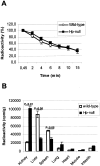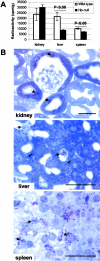Plasma protein haptoglobin modulates renal iron loading
- PMID: 15793279
- PMCID: PMC1602399
- DOI: 10.1016/S0002-9440(10)62319-X
Plasma protein haptoglobin modulates renal iron loading
Abstract
Haptoglobin is the plasma protein with the highest binding affinity for hemoglobin. The strength of hemoglobin binding and the existence of a specific receptor for the haptoglobin-hemoglobin complex in the monocyte/macrophage system clearly suggest that haptoglobin may have a crucial role in heme-iron recovery. We used haptoglobin-null mice to evaluate the impact of haptoglobin gene inactivation on iron metabolism. Haptoglobin deficiency led to increased deposition of hemoglobin in proximal tubules of the kidney instead of the liver and the spleen as occurred in wild-type mice. This difference in organ distribution of hemoglobin in haptoglobin-deficient mice resulted in abnormal iron deposits in proximal tubules during aging. Moreover, iron also accumulated in proximal tubules after renal ischemia-reperfusion injury or after an acute plasma heme-protein overload caused by muscle injury, without affecting morphological and functional parameters of renal damage. These data demonstrate that haptoglobin crucially prevents glomerular filtration of hemoglobin and, consequently, renal iron loading during aging and following acute plasma heme-protein overload.
Figures







References
-
- Hentze MW, Muckenthaler MU, Andrews NC. Balancing acts: molecular control of mammalian iron metabolism. Cell. 2004;117:285–297. - PubMed
-
- Roy CN, Andrews NC. Recent advances in disorders of iron metabolism: mutations, mechanisms and modifiers. Hum Mol Genet. 2001;10:2181–2186. - PubMed
-
- Hoffmann R EJB, Jr, Shattil SJ, Furie B, Cohen HJ, Silberstein LE. London: Churchill Livingstone; HematologyBasic Principles and Practice. (ed 2) 1995
-
- Wang Y, Kinzie E, Berger FG, Lim SK, Baumann H. Haptoglobin, an inflammation-inducible plasma protein. Redox Rep. 2001;6:379–385. - PubMed
-
- Kristiansen M, Graversen JH, Jacobsen C, Sonne O, Hoffman HJ, Law SK, Moestrup SK. Identification of the haemoglobin scavenger receptor. Nature. 2001;409:198–201. - PubMed
Publication types
MeSH terms
Substances
LinkOut - more resources
Full Text Sources
Medical
Molecular Biology Databases

